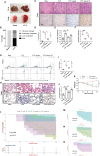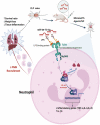MicroLet-7b Regulates Neutrophil Function and Dampens Neutrophilic Inflammation by Suppressing the Canonical TLR4/NF-κB Pathway
- PMID: 33868293
- PMCID: PMC8044834
- DOI: 10.3389/fimmu.2021.653344
MicroLet-7b Regulates Neutrophil Function and Dampens Neutrophilic Inflammation by Suppressing the Canonical TLR4/NF-κB Pathway
Abstract
Sepsis is a heterogeneous syndrome caused by a dysregulated host response during the process of infection. Neutrophils are involved in the development of sepsis due to their essential role in host defense. COVID-19 is a viral sepsis. Disfunction of neutrophils in sepsis has been described in previous studies, however, little is known about the role of microRNA-let-7b (miR-let-7b), toll-like receptor 4 (TLR4), and nuclear factor kappa B (NF-κB) activity in neutrophils and how they participate in the development of sepsis. In this study, we investigated the regulatory pathway of miR-let-7b/TLR4/NF-κB in neutrophils. We also explored the downstream cytokines released by neutrophils following miR-let-7b treatment and its therapeutic effects in cecal ligation and puncture (CLP)-induced septic mice. Six-to-eight-week-old male C57BL/6 mice underwent CLP following treatment with miR-let-7b agomir. Survival (n=10), changes in liver and lungs histopathology (n=4), circulating neutrophil counts (n=4), the liver-body weight ratio (n=4-7), and the lung wet-to-dry ratio (n=5-6) were recorded. We found that overexpression of miR-let-7b could significantly down-regulate the expression of human-derived neutrophilic TLR4 at a post-transcriptional level, a decreased level of proinflammatory factors including interleukin-6 (IL-6), IL-8, tumor necrosis factor α (TNF-α), and an upregulation of anti-inflammatory factor IL-10 in vitro. After miR-let-7b agomir treatment in vivo, neutrophil recruitment was inhibited and thus the injuries of liver and lungs in CLP-induced septic mice were alleviated (p=0.01 and p=0.04, respectively), less weight loss was reduced, and survival in septic mice was also significantly improved (p=0.013). Our study suggested that miR-let-7b could be a potential target of sepsis.
Keywords: COVID-19; MicroLet-7b; TLR4/NF-κB; inflammation; neutrophil; sepsis.
Copyright © 2021 Chen, Han, Chen, Xie, Yang, Zhou, Zhang and Xia.
Conflict of interest statement
The authors declare that the research was conducted in the absence of any commercial or financial relationships that could be construed as a potential conflict of interest.
Figures






Similar articles
-
Let-7b is involved in the inflammation and immune responses associated with Helicobacter pylori infection by targeting Toll-like receptor 4.PLoS One. 2013;8(2):e56709. doi: 10.1371/journal.pone.0056709. Epub 2013 Feb 20. PLoS One. 2013. PMID: 23437218 Free PMC article.
-
MicroRNA-27a alleviates LPS-induced acute lung injury in mice via inhibiting inflammation and apoptosis through modulating TLR4/MyD88/NF-κB pathway.Cell Cycle. 2018;17(16):2001-2018. doi: 10.1080/15384101.2018.1509635. Epub 2018 Sep 19. Cell Cycle. 2018. PMID: 30231673 Free PMC article.
-
[β1 receptor blocker decreases the myocardial inflammation in the sepsis adult rats through inhibition of TLR4/NF-ΚB signaling pathway].Zhonghua Wei Zhong Bing Ji Jiu Yi Xue. 2019 Feb;31(2):193-197. doi: 10.3760/cma.j.issn.2095-4352.2019.02.014. Zhonghua Wei Zhong Bing Ji Jiu Yi Xue. 2019. PMID: 30827308 Chinese.
-
The Role of Nuclear Factor Kappa B (NF-κB) in Development and Treatment of COVID-19: Review.Int J Mol Sci. 2022 May 9;23(9):5283. doi: 10.3390/ijms23095283. Int J Mol Sci. 2022. PMID: 35563673 Free PMC article. Review.
-
The Yin and Yang of TLR4 in COVID-19.Cytokine Growth Factor Rev. 2025 Apr;82:70-85. doi: 10.1016/j.cytogfr.2024.10.001. Epub 2024 Oct 9. Cytokine Growth Factor Rev. 2025. PMID: 39490235 Review.
Cited by
-
Acellular Human Amniotic Fluid-Derived Extracellular Vesicles as Novel Anti-Inflammatory Therapeutics against SARS-CoV-2 Infection.Viruses. 2024 Feb 9;16(2):273. doi: 10.3390/v16020273. Viruses. 2024. PMID: 38400048 Free PMC article.
-
Characterization of Altered Gene Expression and Histone Methylation in Peripheral Blood Mononuclear Cells Regulating Inflammation in COVID-19 Patients.J Immunol. 2022 Apr 15;208(8):1968-1977. doi: 10.4049/jimmunol.2101099. Epub 2022 Apr 4. J Immunol. 2022. PMID: 35379747 Free PMC article.
-
MicroRNA Changes Up to 24 h following Induced Hypoglycemia in Type 2 Diabetes.Int J Mol Sci. 2022 Nov 24;23(23):14696. doi: 10.3390/ijms232314696. Int J Mol Sci. 2022. PMID: 36499023 Free PMC article. Clinical Trial.
-
Neutrophils and the Systemic Inflammatory Response Syndrome (SIRS).Int J Mol Sci. 2023 Aug 30;24(17):13469. doi: 10.3390/ijms241713469. Int J Mol Sci. 2023. PMID: 37686271 Free PMC article. Review.
-
mmu-miR-145a-5p Accelerates Diabetic Wound Healing by Promoting Macrophage Polarization Toward the M2 Phenotype.Front Med (Lausanne). 2021 Dec 21;8:775523. doi: 10.3389/fmed.2021.775523. eCollection 2021. Front Med (Lausanne). 2021. PMID: 34993211 Free PMC article.
References
Publication types
MeSH terms
Substances
LinkOut - more resources
Full Text Sources
Other Literature Sources
Medical
Miscellaneous

